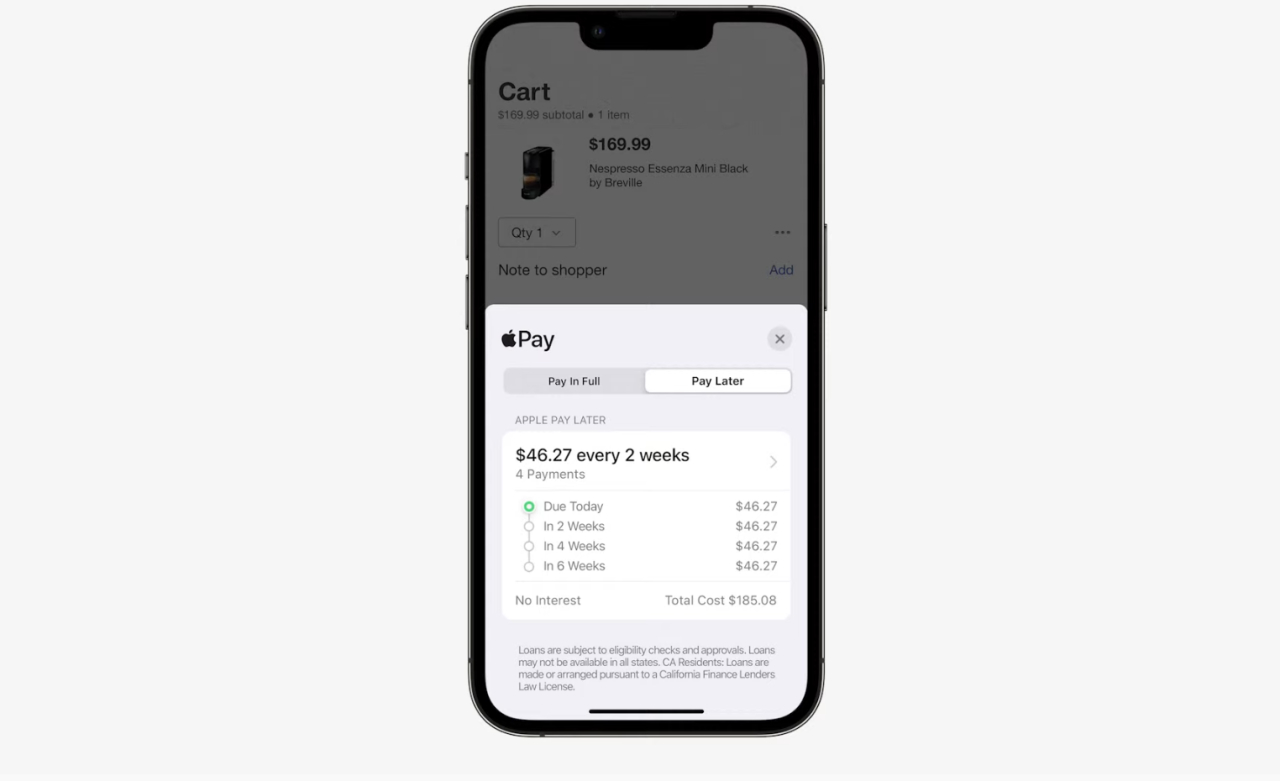While many assumed something like this was coming for months, Apple announcing its intentions to join the competitive Buy Now, Pay Later market still comes as a surprise. And a possible seismic shift for fintech companies like Affirm Holdings, Klarna and Afterpay. Announced earlier this week alongside a whole suite of new features for iOS 16, the tech giant will be introducing Apple Pay Later to its devices later this year. Designed as a BNPL service with no interest fees, the service will be available in the Apple Wallet in partnership with Goldman Sachs Group – likely to be the lender behind the short-term instalment loans available to users – and Mastercard, whose payment network will be used to handle instalment payments.
Apple Pay Later will offer the same convenience many have come to expect from these BNPL services like Afterpay and Klarna, in that users can opt to split payments made via Apple Pay into four equal instalments spread out over six weeks, incurring zero interest fees without Apple adding any fees of its own.
While the Apple BNPL service will be rolling out to US customers first, it shouldn’t be too long before Apple users around the world will benefit from the same frictionless spending function. And of course, this announcement has spelled a bit of an issue for competitors as Apple has become yet another tech giant moving in to try and squash rising fintech companies.
Shares of major BNPL companies have already taken a bit of a tumble in response to the Apple Pay Later announcements, with prices of Affirm Holdings (NASDAQ: AFRM), PayPal (NASDAQ: PYPL) and Afterpay-owner Block (ASX: SQ2) falling between 1.1% and 4.8%. The struggling Zip Co (ASX: Z1P) also took a sizable fall of 5.2% while Sezzle Inc (ASX: SZL) fell the most by 14.4%.
“The move into BNPL suddenly makes Apple the most accepted BNPL product out there,” said Vincent Caintic, an analyst at Stephens Inc quoted in Reuters.
Considering the Apple Pay service is used by 85% of US merchants, it’s not hard to see why Apple Pay Later is primed to be so dominant moving forward. Add this to the fact that the BNPL market is currently being asphyxiated by a cost-of-living crisis fueled by geopolitical tensions, rising interest rates and tighter regulatory scrutiny.
And that last one seems to be a sizable thorn for these younger fintech companies. Klarna, for example, has been recently tightening its lending terms and cutting start in order to focus more heavily on profitability in a response to how quickly regulators are zeroing in on fintech. Being able to adapt to these kinds of storms is, of course, vital to long-term growth. Although Appy Pay Later may present more than just a storm to these smaller players.
Apple Pay Later is clearly a play from the tech giant at creating and controlling more financial products by moving them in house rather than relying on third parties. We’ve already seen a similar insular approach by Apple when it moved away from using Intel processors in 2020 and began focusing on using Apple silicon in Mac computers. That has since been a standard approach to newer devices, as products like the iPhone 13 and iPad Air 5 are powered by Apple’s proprietary M1 chip.
It was once hoped by some that Apple would go the partnership route when it came to BNPL much like Amazon has chosen to do by partnering with Affirm. Although perhaps that was a bit naive of investors, seeing as Apple continues to, as mentioned above, move towards shedding as many third parties as possible to further convince more users to jump into the Apple ecosystem.
Apple Pay Later will obviously allow Apple to make more money from fees as well as capture data on the shopping and spending habits of the company’s users. By all means, it’s a smart move, just for some, a potentially devastating one.
As quoted in Reuters, it seems Affirm isn’t too worried about the announcement, with a company spokesperson expressing confidence about the service’s long-term prospects.
“Even as more players join the movement we started, the prize remains massive, and Affirm is well-positioned to win.”
And while Apple Pay Later should be an exciting addition to Apple users, it pays to look a bit more closely at the terms and conditions. We don’t know just yet how Apple will be executing the service and implementing it into the Wallet but we do know users will need to apply to use Apple Pay Later when they are checking out with Apple Pay. Acceptance isn’t guaranteed, of course, and how strict Goldman Sachs is in its approval process could play a big part in Apple Pay Later’s successful rollout.
There also seems to be only one repayment option for Apple Pay Later, at least so far. Other BNPL providers like Afterpay have a much more flexible schedule for making payments. And while there’s little doubt that will change when Apple Pay Later picks up, it also means there could still be space for more than one BNPL product when the dust settles.
















